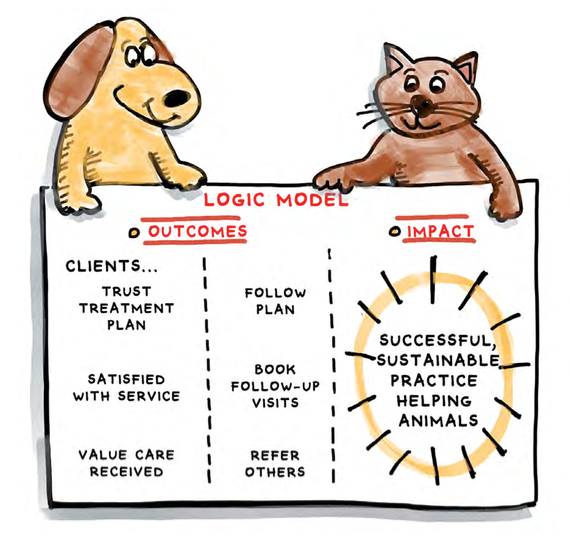Advice Unleashed (August 2017)
Tips and insight from business, financial and practice management experts.

The process of measuring the impact of your practice starts with sketching a logic model, says Caryn Ginsberg, MBA, a strategic visualist at Priority Ventures Group in Arlington, Virginia, a firm that helps businesses and associations reach their goals by thinking visually. “Start by thinking about the ultimate impact you want to create,” she advises. “Then ask yourself what key client behaviors are required to get that result. Finally, step back and evaluate whether you are delivering the services your clients need to develop the attitudes and knowledge that will create that desired behavior.
“For example, if you want to ensure that clients book next year’s visit before they leave your practice today, then they need to feel that they’ve just had a good experience and that it’s important for their pet to see you regularly,” Ginsberg says. Ask yourself: “Are clients seen promptly? Are they able to make appointments within a reasonable amount of time? How are they treated by staff?” The answers to these questions will let you know if you’re delivering the services that will mold clients’ positive attitudes and beliefs and ultimately create the impact you’re looking for.
Opportunities Ahead for WomenLaura Maloney, MBA, principal at the consulting firm Adisa, which helps individuals and teams achieve the impact they desire, believes that leadership for women has changed greatly in the past 20 years. She cites the recent movie “Hidden Figures”
as an example of how far society has come. “It’s hard to believe that in our lifetime, women couldn’t be scientists or doctors,” she says. “So, I think the world has changed significantly, even though it may feel like we’re kind of slugging it out, and even though you still see [a] majority [of] male boards of directors in a field
that is largely female driven. Change has been slower, but I think there are a lot of opportunities ahead for women. Women are coming into their own and feeling their own power.”
Hiring the Right Receptionist
Receptionists should be hired for their attitude and ability to deal with people, says Brian Conrad, CVPM, practice manager for Meadow Hills Veterinary Center in Kennewick, Washington. “I always ask candidates why they are applying to my hospital, and overwhelmingly the answer is ‘because I love pets,’” he says. “But I’m always waiting for someone to come in and say, ‘It’s because I love people,’ because for every minute a receptionist spends with the pets, he or she spends probably two minutes with the people, and I think many receptionist candidates fail to realize that. I can teach and coach just about anybody as long as the person has the correct attitude and work ethic, is a ‘people person,’ and realizes that the only reason we exist is because of the clients and the pets.”
Easing the Student Debt Burden
Veterinarians can better manage their student debt in several ways, says Tony Bartels, DVM, MBA, a consultant for the Veterinary Information Network. “Income-driven repayment is a huge tool that folks can use, particularly when they’re just getting started,” he says. These federal repayment programs allow you to base your student loan payment on your income. “[That] can be huge when you have a debt-to-income ratio that’s greater than two, which many graduating veterinarians have,” he says.
Another tool at your disposal: Public Service Loan Forgiveness. “This program can help pay your loans to zero without a taxable forgiveness at the end if you do the right kinds of things — work for the right kind of organization, make the right kind of payments toward your loans and utilize the right repayment programs,” says Dr. Bartels.

To create a top-notch team at your practice, be sure you have a sound mentoring program in place, suggests Amanda Landis-Hanna, DVM, senior manager of veterinary outreach for PetSmart Charities. “I’m always intrigued by the different ways hospitals cross-train,” she says. “Some of the most effective hospitals I’ve been
in have provided really extensive mentoring programs to make sure the associate veterinarians are continuing to be engaged [and] challenged and learn new things, but so are the veterinary technicians, practice managers and receptionists. We’re all part of the same team, and we all deserve to be challenged and to be constantly improving. Providing a solid mentoring program can be a really great way to do that.”
Attention, Students: Hone Your Financial SkillsMike Chaddock, DVM, EML, associate dean of the College of Veterinary Medicine at Michigan State University, explains why veterinary students should master basic personal finance skills before entering college: “Students just starting veterinary school have a responsibility to know a little bit about personal finance. What does it cost to live? What does it cost to buy groceries? What is a checkbook? What is a credit card? How do I reconcile my credit card statement?
“Now, I’m not saying that none of them know how to do this, but if I were sending my children to school today, these are things that I would teach them at home,” Dr. Chaddock says. “So, when they come to school and all of a sudden they’re faced with taking out a student loan, understanding the payment schedule and trying to understand the interest rates, they have this knowledge coming in. That would be very, very helpful, and that doesn’t only pertain to being a veterinarian — that just pertains to growing up.”

Find a Better Motivator
“The most common motivation problem in veterinary practice is not understanding what motivation is,” says Wendy Hauser, DVM, assistant vice president of veterinary relations for Crum + Forster Pet Insurance Group. She says that most veterinarians use extrinsic motivation — the carrot-and-stick approach — but that works for only so long. “It’s actually a very poor-quality motivator,” she says. “People can only be motivated by themselves, so what we need to do is ask team members what motivates them. When we match their tasks to align with their core values and with what motivates them, then we’ll have better performance.”

When dealing with a veterinarian who is resistant to change, Kristen Cooley, BA, CVT, VTS (Anesthesia/Analgesia), an instructional specialist at the University of Wisconsin School of Veterinary Medicine, says you have to look at the situation from that person’s perspective. She recommends finding the barriers and then trying to break them down. “Just to get somebody to make a change can be difficult,” she admits. “Whether you’re successful depends on how you approach it. You need to be careful to not blame, to not be combative and to not reach out in a way that would make the veterinarian feel like he or she is doing something wrong. Make it seem as though the change is their idea, or make it profitable to the practice.”
